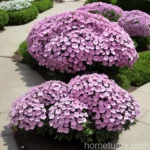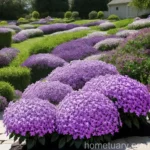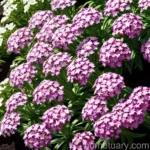The Beauty of Garden Phlox (Phlox paniculata ‘David’)
Garden phlox, scientifically known as Phlox paniculata ‘David’, is a stunning perennial plant renowned for its vibrant and fragrant flowers. As a plant scientist with a passion for horticulture, I am thrilled to share insights into the cultivation, care, and maintenance of this beautiful species. In this comprehensive guide, we will explore the cultural aspects, uses, growing conditions, maintenance practices, and fascinating facts about Phlox paniculata ‘David’.
What is Garden Phlox (Phlox paniculata ‘David’)?
Garden phlox (Phlox paniculata) is a species of flowering plant in the family Polemoniaceae, native to parts of the United States and Canada. ‘David’ is a specific cultivar within the Phlox paniculata species, prized for its pure white blossoms and robust growth habit. This perennial plant is cherished by gardeners for its profusion of fragrant, densely clustered flowers that bloom in mid to late summer, adding splendor to gardens and landscapes.
Key Takeaways – Garden Phlox (Phlox paniculata ‘David’)
Before delving into the specifics of cultivating and caring for Phlox paniculata ‘David’, let’s highlight the key takeaways regarding this captivating plant.
- Scientific Name: Phlox paniculata ‘David’
- Common Name: Garden phlox
- Plant Type: Perennial
- Flower Color: Pure white
- Flowering Season: Mid to late summer
- Fragrance: Fragrant
- Uses: Borders, mixed plantings, cut flowers, pollinator gardens
- Characteristics: Clump-forming, upright growth, lance-shaped leaves
- Maintenance: Moderate
- Special Features: Attracts butterflies and hummingbirds
- Hardiness Zones: 4–8
Now, let’s embark on a journey to uncover the intricacies of cultivating and caring for garden phlox, focusing on the cultural aspects, uses, growing conditions, maintenance practices, and noteworthy facts about Phlox paniculata ‘David’.
Culture
Uses
Garden phlox (Phlox paniculata ‘David’) serves various purposes in garden landscapes and horticultural settings. Here are the primary uses of this charming plant:
- Borders: Garden phlox is commonly used to create stunning borders due to its tall and elegant flower spikes, which provide vertical interest in garden beds.
- Mixed Plantings: It serves as an excellent addition to mixed plantings, combining well with other perennials and shrubs to create visually appealing compositions.
- Cut Flowers: The fragrant blossoms of ‘David’ garden phlox make splendid cut flowers, adorning vases and indoor arrangements with their pristine white blooms.
- Pollinator Gardens: With its abundant nectar, garden phlox attracts pollinators such as butterflies and hummingbirds, making it a valuable addition to wildlife-friendly gardens.
Water
Proper watering is crucial for the health and vitality of Phlox paniculata ‘David’. Here are some essential watering tips to ensure optimal growth and flowering:
- Regular Watering: Garden phlox benefits from regular watering, especially during dry periods. Ensure that the soil remains consistently moist but not waterlogged.
- Avoid Overhead Watering: To prevent foliage diseases, it is advisable to water the soil directly at the base of the plant, avoiding overhead watering that can lead to leaf wetness and susceptibility to diseases.
Sunlight
The sunlight requirements of garden phlox are essential considerations for its successful cultivation. Here’s what you need to know about its sunlight preferences:
- Full Sun to Partial Shade: Phlox paniculata ‘David’ thrives in locations with full sun to partial shade. Providing at least 6 hours of direct sunlight each day is ideal for robust growth and abundant flowering.
- Morning Sun and Afternoon Shade: In warmer climates, offering morning sun and afternoon shade can help protect the plant from excessive heat and prevent wilting.
Fertilizer
Fertilizing garden phlox is an integral part of its care regimen to ensure vigorous growth and prolific flowering. Here are some key points to consider when fertilizing Phlox paniculata ‘David’:
- Balanced Fertilizer: Use a balanced, slow-release fertilizer in early spring to provide essential nutrients for healthy growth and abundant blooms. A formulation such as 10-10-10 can be suitable for garden phlox.
- Avoid Excessive Nitrogen: To prevent excessive foliage growth at the expense of flowering, refrain from using high-nitrogen fertilizers that may promote lush foliage at the expense of blooms.
Soil
The soil composition and quality play a vital role in the overall health and performance of garden phlox. Here’s what you need to know about the soil requirements for Phlox paniculata ‘David’:
- Well-Draining Soil: Ensure that the planting site offers well-draining soil to prevent waterlogging, which can lead to root rot and other issues.
- Rich in Organic Matter: Amending the soil with organic matter, such as compost or well-rotted manure, enhances its fertility and texture, providing an optimal growing medium for garden phlox.
- Soil pH: Garden phlox thrives in slightly acidic to neutral soil with a pH range of 6.0 to 7.0. Conduct a soil test to assess the pH and make necessary adjustments using amendments if needed.
Pruning
Pruning is a valuable practice in maintaining the health, appearance, and flowering performance of Phlox paniculata ‘David’. Here are the essential pruning guidelines for garden phlox:
- Deadheading: Regular deadheading of faded flowers promotes continuous blooming and prevents the plant from directing its energy into seed production.
- Cutting Back: In late fall or early spring, prune the stems of garden phlox to ground level to rejuvenate the plant and encourage robust growth and flowering in the upcoming season.
Propagation
The propagation of garden phlox enables gardeners to expand their plantings and share the beauty of Phlox paniculata ‘David’. Here are the primary methods of propagating garden phlox:
- Division: Divide mature clumps of garden phlox in early spring, carefully separating the root ball into smaller sections while ensuring that each division has healthy roots and shoots. Replant the divisions in suitable locations, and provide adequate moisture and care to establish new growth.
- Stem Cuttings: Propagate garden phlox by taking stem cuttings in midsummer. Select healthy, non-flowering stems, and trim them to obtain 4- to 6-inch cuttings. Remove the lower leaves, dip the cut ends in rooting hormone, and plant the cuttings in a suitable rooting medium. Provide warmth, humidity, and gentle moisture to encourage root development.
Container Popularity
While garden phlox is predominantly grown in garden beds and borders, its appeal extends to container gardening as well. Here are some considerations for cultivating Phlox paniculata ‘David’ in containers:
- Container Selection: Choose spacious containers with adequate drainage holes to accommodate the root system of garden phlox and prevent waterlogging.
- Potting Medium: Use a well-draining potting mix rich in organic matter to provide a suitable growing environment for ‘David’ garden phlox in containers.
- Watering: Containers may require more frequent watering, especially during the warm months, to ensure that the potting mix remains consistently moist but not waterlogged.
- Sun Exposure: Place the containers in locations that receive ample sunlight, as garden phlox thrives in full sun to partial shade.
Common Diseases
While garden phlox is generally robust, it is susceptible to certain diseases that can impact its health and performance. Here are some common diseases that may affect Phlox paniculata ‘David’ and their diagnostic signs:
Disease Diagnosis
- Powdery Mildew (Erysiphe cichoracearum): Powdery mildew manifests as a powdery white fungal growth on the foliage, often causing distortion and yellowing of the leaves. It thrives in conditions of high humidity and limited air circulation.
- Botrytis Blight (Bortytis cinerea): This fungal disease causes brown to grayish velvety spots on the leaves and stems, often accompanied by wilting and soft rot of affected tissues. It thrives in damp and cool conditions.
- Root Rot (Various Pathogens): Root rot may occur due to excessively wet or waterlogged soil, leading to the decay of the root system and subsequent wilting and decline of the plant. Affected roots may appear dark, mushy, and malodorous.
- Leaf Spot (Various Fungal Pathogens): Leaf spot diseases lead to the formation of dark, often circular lesions on the foliage, potentially causing premature leaf drop and defoliation.
Common Pests
In addition to diseases, garden phlox may encounter pests that can impact its growth and vitality. Here are some common pests that may affect Phlox paniculata ‘David’ and their management strategies:
Pest Control
- Spider Mites (Tetranychidae): Spider mites are tiny arachnids that may cause stippling and discoloration of the leaves, accompanied by fine webbing on the plant. Regularly spraying the foliage with a strong stream of water can help deter and control spider mite infestations.
- Aphids (Aphidoidea): Aphids are small, sap-sucking insects that may cluster on the tender shoots and flower buds of garden phlox, potentially causing distortion and stunted growth. Control aphid populations by spraying the plant with insecticidal soap or horticultural oil.
- Caterpillars (Lepidoptera): Certain caterpillar species may feed on the foliage of garden phlox, resulting in ragged leaves and defoliation. Handpicking caterpillars and deploying biological control agents such as Bacillus thuringiensis (Bt) can effectively manage caterpillar infestations.
Botanist’s Tips
As a plant scientist with a keen interest in garden phlox, I offer the following tips and recommendations for cultivating and caring for Phlox paniculata ‘David’:
Fun Facts
Garden phlox is not only esteemed for its beauty but also for its intriguing characteristics and historical significance. Here are some enchanting fun facts about ‘David’ garden phlox:
- Historical Significance: Phlox paniculata is the official flower of the state of Tennessee, USA, honored for its resplendent blooms and cultural significance.
- Fragrant Flowers: The blossoms of ‘David’ garden phlox exhibit a delightful, sweet fragrance, attracting pollinators and enchanting garden enthusiasts with their alluring scent.
- Color Variations: While ‘David’ garden phlox boasts pure white blossoms, the Phlox paniculata species encompasses a diverse array of flower colors, including shades of pink, purple, and red.
- Wildlife Attraction: In addition to attracting butterflies and hummingbirds, garden phlox is known for its appeal to various native pollinators, contributing to ecological diversity and floral abundance.
Links to External Resources
For further exploration and in-depth information on Phlox paniculata ‘David’ and related topics, I recommend the following external resources:
- The American Phlox Society: An authoritative organization dedicated to the cultivation, preservation, and appreciation of phlox species, providing valuable insights and resources for enthusiasts.
- Royal Horticultural Society – Growing Phlox: The Royal Horticultural Society offers comprehensive guidance on growing phlox, including care tips and cultivation recommendations.
- University of Florida IFAS Extension – Phlox Diseases: Detailed information on common diseases affecting garden phlox, along with diagnostic techniques and disease management strategies.
With its elegance, fragrance, and ecological contributions, Phlox paniculata ‘David’ holds a special place in the hearts of gardeners and plant enthusiasts. By embracing the cultural insights, maintenance practices, and botanical marvels of garden phlox, we can celebrate its enduring beauty and enrich our horticultural experiences.
As we navigate the realms of plant science and horticulture, Phlox paniculata ‘David’ stands as a testament to the resplendence of nature and the joys of cultivating exceptional botanical treasures in our gardens and landscapes.
As a plant scientist and advocate for botanical diversity, I am thrilled to have the opportunity to delve into the captivating world of garden phlox and share insights on cultivating and caring for the esteemed Phlox paniculata ‘David’. With its pure white blossoms, fragrant allure, and ecological contributions, this perennial plant enriches our gardens and beckons us to embrace its natural charm.
Whether adorning borders, attracting pollinators, or gracing floral arrangements, ‘David’ garden phlox captures the imagination and celebrates the exuberance of nature. As we continue to discover and cherish the wonders of garden phlox, let us foster a deeper appreciation for the botanical marvels that enrich our lives and landscapes.















